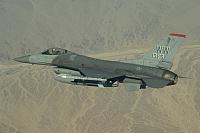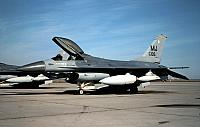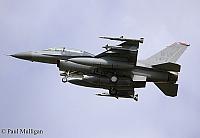 |
13th Fighter Squadron ( USAF PACAF)" Panthers" |
 |
13 FS " Panthers" ( USAF PACAF) | |||
| Status: |
Active
|
|||
| Version: | F-16C/D block 50 | |||
| Role: | Multirole, SEAD | |||
| Tailband: | Red | |||
| Motto: | N/A | |||
| Badge: | N/A | |||
F-16 History
In the mid eighties the USAF decided that their presence in the Pacific area needed a boost. In the first place this was directed at strengthening their presence on the Korean peninsula, but since the 8th FW was already present on the island as well as numerous Korean units themselves, space was relatively limited. Therefore the USAF decided to strengthen their presence in Japan. This country didn’t have the disadvantages of Korea and modern infrastructure was already present. Two units were created under the newly formed 432nd TFW (later redesignated to 35th TFW), being the 13th and 14th TFS. The 13th was reactivated in 1985 receiving block 15 airframes that the 363rd TFW at Shaw AFB was phasing out due to the arrival of newer equipment over there. These airframes were mainly tasked with air defense, with a limited attack duty as well.
Soon the USAF decided on replacing these airframes with newer versions that made more of a multirole capability possible. In the first place factory fresh block 30 airframes were delivered to the unit. The first airframes were received in 1987 with IOC being reached in early 1988. Those block 30 airframes came with a lot of advantages. They had a more powerful engine and the new APG-68 radar. New weapon systems were also installed and a nightly attack capability was added as well.
Already in 1990 these airframes were again swapped for other ones. The block type stayed the same – being block 30 airframes – but they were of the so-called ‘big inlet’ version. With this modification the full extent of the General Electric F110 engine came into being, giving better overall performance of these jets. The mission of the squadron remained practically the same.
In 1994 the squadron was converted to the block 50 of the viper. In general this added some functionality again. More specifically this also meant that the Suppression of Enemy Air Defenses (SEAD) mission was added to the mission profile of the squadron. Over the years new electronics and weapon systems were introduced on these airframes, but their role remained the same for the past 18 years.
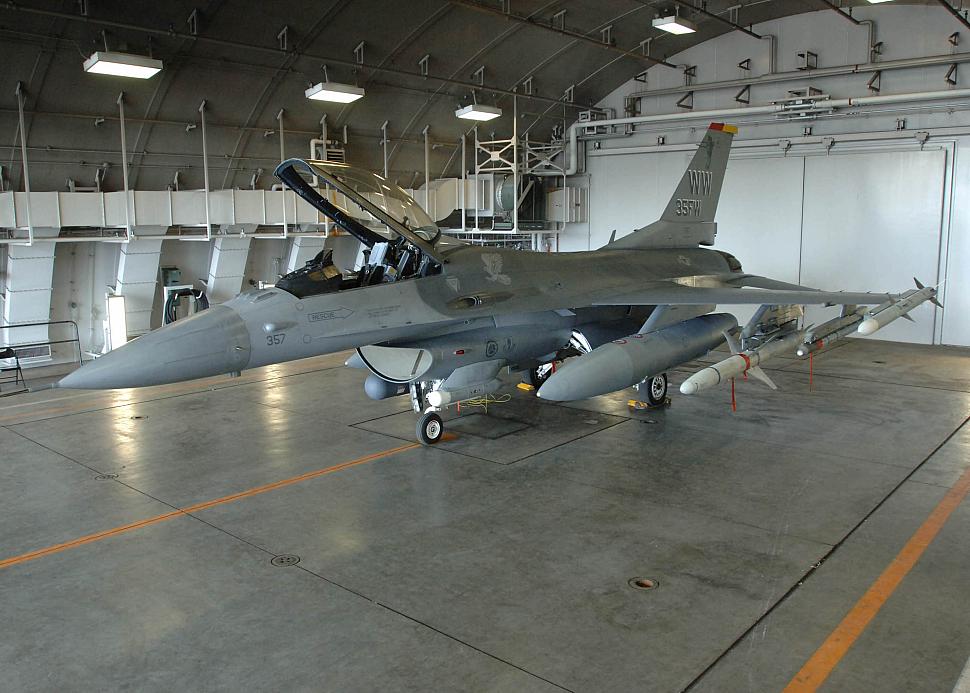
Aircraft Markings History
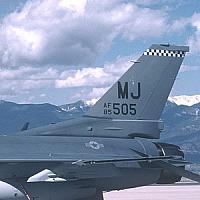
The tail consist of a black and white checkered tailband with the 'MJ' tailcode in the center - meaning Misawa Japan - and the serial underneath.
The general lay-out remained the same. The tailband changed color to red and a little PACAF logo was added beneath it.
The lay-out remained unchanged, but the tailcode was changed to 'WW', referring to the Wild Weasel mission of the squadron.
Yet again the lay-out remained unchanged. Above the tailcode the squadron mascot - a panther - was added in toned down markings.
Unit History
- 1942: Activation of the squadron in Bowman, Kentucky (as 313 BS)
- 1942: B-18 'Bolo' (part of 21 BG)
- 1942: B-18 'Bolo' (Jackson AAB, Mississippi)
- 1942: B-18 'Bolo' (Columbia AAB, South Carolina)
- 1942: A-20 'Havoc' (Key Field, Mississippi)
- 1942: A-20 'Havoc' (Hattiesburg AAB, Mississippi)
- 1942: A-20 'Havoc' (Key Field, Mississippi)
- 1942: B-25 'Mitchell' (Mac Dill Field, Florida)
- 1942: B-26 'Marauder'
- 1943: Disbanded
- 1966: Activation of the squadron in Korat [Thai.] (as 13 TFS)
- 1966: F-105 'Thunderchief' (part of 18 TFW)
- 1967: F-4D 'Phantom II' (part of 432 TRW, Udorn AFB [Thai.])
- 1975: Deactivated
- 1976: Activation of the squadron in Mac Dill, Florida
- 1976: F-4E 'Phantom II' (part of 56 TTW)
- 1982: Disbanded
- 1985: Activation of the squadron in Misawa [Jap.]
- 1985: F-16A/B 'Fighting Falcon' (part of 432 TFW)
- 1987: F-16C/D 'Fighting Falcon'
- 1991: F-16C/D 'Fighting Falcon' (part of 432 FW)
- 1994: F-16C/D 'Fighting Falcon' (part of 35 OG)
Deployments
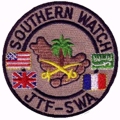 |
' Southern Watch' |
| Dhahran AB, Saudi Arabia [12 F-16s] (July of 1997 to December of 1996) | |
| Operation Southern Watch was an operation which was responsible for enforcing the United Nations mandated no-fly zone below the 32nd parallel in Iraq. This mission was initiated mainly to cover for attacks of Iraqi forces on the Iraqi Shi’ite Muslims. After the bombing at Khobar Towers, six aircraft went to Shaikh Isa AB, Bahrain and the other six went to Prince Sultan AB, Saudi Arabia. The mission was the first in the squadron's Southern Watch commitment. | |
 |
' Southern Watch' |
| Prince Sultan AB, Saudi Arabia (April of 1998 to July of 1998) | |
| This marked the unit's second deployment to South East Asia. A total of 250 personnel was deployed to fulfill this mission. | |
 |
' Southern Watch' |
| Prince Sultan AB, Saudi Arabia [8 F-16s] (June of 1999 to September of 1999) | |
| This was one of the smaller detachments that went to South East Asia. Also a mere 150 personnel was deployed at the time. The mission of the unit stayed fairly the same as in previous deployments. | |
 |
' Southern Watch' |
| Prince Sultan AB, Saudi Arabia (March of 2000 to May of 2000) | |
| After being home for a mere 6 months, the squadron was rotated back into theatre. This time it was a regular deployment for a three-month period on station. | |
 |
' Northern Watch' |
| Incirlik AB, Turkey (July of 2001 to September of 2001) | |
| Operation Northern Watch was a US European Command Combined Task Force (CTF) who was responsible for enforcing the United Nations mandated no-fly zone above the 36th parallel in Iraq. This mission was a successor to Operation Provide Comfort which also entailed support for the Iraqi Kurds. | |
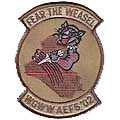 |
' Southern Watch' |
| Prince Sultan AB, Saudi Arabia (2002) | |
| This marked the final deployment in the Southern Watch series of deployments to Iraq. After this the military operation to overthrow Saddam Hussein was started and the mission was redefined. | |
 |
' Iraqi Freedom' |
| Balad AB, Iraq [12 F-16s] (January 19th, 2007 to October 12th, 2007) | |
| Twelve aircraft were sent from both 35th FW squadrons in January of 2007 in the roll of Close Air Support. This was a new roll for the 35th FW which largely trains for SEAD. The 14th FS flew the first half of the deployment under rotation AEF 5/6. With aircraft already in theatre, the 13th FS arrived to complete rotation AEF 7/8. On July 15th, 2007 F-16C #92-3901, from the 13th FS, was lost during takeoff from Balad AB, Iraq. The pilot ejected safely but the aircraft was a write off. At least two aircraft were sent to replace the one lost on July fifteenth. In the end the aircraft deployed flew 2,800 sorties spanning 11,500 hours. Returning pilots had to re-qualify for the SEAD mission. | |
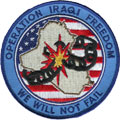 |
' Iraqi Freedom' |
| Balad AB, Iraq (September 18th, 2008 to January 11th, 2009) | |
| This marked the final rotation of the squadron in the struggle to free Iraq. This was a lengthy deployment that covered almost 5 months. | |
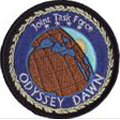 |
' New Dawn' |
| Balad AB, Iraq [9 F-16s] (January 7th, 2011 to June 2nd, 2011) | |
| At least 9 aircraft, including some borrowed from the 14th FS, deployed to Iraq in support of Operation New Dawn. This operation replaced Operation Iraqi Freedom on September 1st, 2010 and is the part of the campaign intended to be the withdrawl from Iraq. |
F-16 Airframe Inventory
- All 13 FS F-16s in our F-16 Aircraft Database (past and current aircraft)
- Current 13 FS F-16s in our F-16 Aircraft Database
Photos
Please use this form to add any list any error or omissions you find in the above text.
Note: your comments will be displayed immediately on this page. If you wish to send a private comment to the webmasters, please use the Contact Us link.



